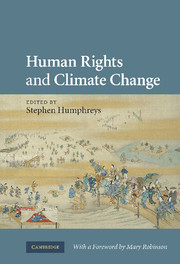Book contents
- Frontmatter
- Contents
- Authors' biographies
- Acronyms
- Acknowledgements
- Foreword
- Introduction: human rights and climate change
- PART I Rights perspectives on global warming
- 1 Competing claims: human rights and climate harms
- 2 Climate change, human rights and moral thresholds
- 3 Equitable utilization of the atmosphere: a rights-based approach to climate change?
- 4 Climate change, human rights and corporate accountability
- 5 Rethinking human rights: the impact of climate change on the dominant discourse
- PART II Priorities, risks and inequities in global responses
- Conclusion
- Appendix: climate change impacts on human rights
- Index
- References
1 - Competing claims: human rights and climate harms
from PART I - Rights perspectives on global warming
Published online by Cambridge University Press: 04 August 2010
- Frontmatter
- Contents
- Authors' biographies
- Acronyms
- Acknowledgements
- Foreword
- Introduction: human rights and climate change
- PART I Rights perspectives on global warming
- 1 Competing claims: human rights and climate harms
- 2 Climate change, human rights and moral thresholds
- 3 Equitable utilization of the atmosphere: a rights-based approach to climate change?
- 4 Climate change, human rights and corporate accountability
- 5 Rethinking human rights: the impact of climate change on the dominant discourse
- PART II Priorities, risks and inequities in global responses
- Conclusion
- Appendix: climate change impacts on human rights
- Index
- References
Summary
To speak of climate change and human rights in the same breath is not merely to draw a connection between the activities that generate global warming and the subsequent deterioration of many human rights – a connection that is self-evident even if relatively unexplored (see my Introduction to this volume). It is also to juxtapose two very different bodies of professional expertise and spheres of international law, which comprise two disciplines or discourses, or ways of thinking and speaking about society and government and the place of the individual, about public and private obligations, responsibilities and solutions – and, indeed, about international cooperation and obligation. In the following overview of the relation between human rights and climate change, I begin by taking a wide-angle view of the justice questions that climate change raises, and then look at some of the ways in which the existing human rights regime and nascent climate regime treat them, in order to identify common themes and compatibilities between two regimes whose mutual disregard to date offers a good example of a phenomenon that has been called the ‘fragmentation of international law’.
That contact between these two disciplines has been largely absent to date is on its face surprising. Quite aside from the human rights implications of climate change, these are two areas of activity, whose recent evolution is contemporaneous, each accelerating around the end of the 1980s.
- Type
- Chapter
- Information
- Human Rights and Climate Change , pp. 37 - 68Publisher: Cambridge University PressPrint publication year: 2009
References
- 5
- Cited by

